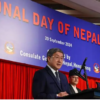Kathmandu, Sept 21: Three formidable figures came together to write a book on an epoch-making concern- artificial intelligence (AI). The book named ‘The Age of AI and Our Human Future’ was co-authored by Henry A. Kissinger, Eric Schmidt and Daniel Huttenlocher.
The book brings to light the trepidation associated with the defining topic of the hour, AI; the past technological endeavours and computer engineering to usher us in the present advancement, and the future prospects and potentials. The writers make clarion calls: Ensure human rights in AI development and deployment. “Created by humans, AI should be overseen by humans,” they underscore. They are for the prevailing human conscience over AI activities.
The book is divided into seven chapters: a) Where We Are, b) How We Got Here: Technology and Human Thought, c) From Turing to Today- and Beyond, d) Global Network Platforms, e) Security and World Order, f) AI and Human Identity, and g) AI and Future. Every chapter succinctly provides related information and evolution that relates to AI.
The first chapter ‘Where We Are’ has a vivid description of the current stage. It finely summarizes the achievements of AI we are enjoying, and concurrent fear and obsession of panacea and doom. “While the number of individuals capable of creating AI is growing, the ranks of those contemplating this technology’s implications for humanity- social, legal, philosophical, spiritual, moral- remain dangerously thin,” the trio warned. As we gradually outsource AI for almost every aspect we behave with, the utter absence of ‘self-awareness’ in AI is the point where the human role is urgent. The references to AlphaZero’s victory, a spurt of GPT-3, and the discovery of ‘halicin’ by AI are some significant subjects explained in this chapter.
The discovery of ‘halicin’ was a milestone in medicine made possible by deep learning. “The AI that discovered halicin has expanded human researchers’ concepts both narrow (bacteria eradication, drug delivery) and broad (disease, medicine, health)”, they observed. The discovery will certainly revolutionize these sectors, thereby hugely benefiting human life. AlphaZero had a pivotal role in expanding the human conception of chess, while GPT-3 bewildered humans with previously unfeasible tasks easily doable- translation, editing, content writing, text and pictures, films.
Similarly, the second chapter ‘How We Got Here’ reminds the readers that technological progress and prowess have an adequate background of the society that fosters discourse and debates on emerging issues. “During the revolutionary era, innovative technology, novel paradigms, and widespread political and social adaptations reinforced one another,” they argued. It suggests that technological development does not advance piecemeal, but is bolstered by other factors in society.
Indeed, the societies that failed or slowed to whet adequate discussions on the social and political fronts did not witness IT progress as compared to the societies that favoured an atmosphere open and free for exchanges of innovative ideas. The Western world’s revolutions in the fifteenth and sixteenth centuries formed concepts on roles of the human mind and conscience that helped cope with reality, according to them.
Chapter four: ‘Global Network Platforms’ is another compelling study on the digital networks that have spanned across the world- people stuck to these for many activities. Initially launched to connect the people and foster a borderless society, the network platforms have emerged so mighty that their presence began threatening national and international governance. The adoption of AI by these networks with gradual sophistication is behind the trepidation. With the vast gathering of users’ data and customization, the users are lured to glue to these platforms, and victimized by the manipulation and disinformation in many cases. “As AI becomes increasingly critical to network platforms functioning, it is also becoming, gradually and unobtrusively, a sorter and shaper of reality- and, in effect, an actor on the national and global stage.” As the writers have suggested and cautioned in this chapter, the subsequent activities of the Meta and X prove their observation.
They also bring the references of TikTok ban in different countries, reasoning the breach of users’ data and privacy. With references to the perception of the US, China, Europe, India, Russia, and South East Asia towards network platforms, the writers made analyses of the platforms from the geopolitical perspective as well.
“In Beijing, Washington, and some European capitals, concern has been expressed (and articulated obliquely elsewhere) about the implications of conducting broad aspects of the national economic and social life of network platforms facilitated by AI designed in other, potentially rival, countries,” they stated.
The chapter: ‘Security and World Order’ also captivates the readers by showing the security dimension is changing with AI adoption which ultimately affects the world order. In the absence of security, human society cannot function smoothly and in a peaceful manner. The society remains an organized whole once the security is in place. But when security is defined and determined by evolving issues like AI, the society warrants new approaches to cope with and survive in an order. “The AI era risks complicating the riddles of modern strategy beyond human intention- or perhaps complete human comprehension,” they mentioned, showing an urgency of taming the use of AI for humankind.
Moreover, they project and recommend that within some decades, it is essential to secure a balance of power, taking into account the intangibles of cyber conflicts, massive disinformation and characteristic qualities of AI-fueled war.
In the chapter ‘From Turing to Today- and Beyond’, there is a description of the Turing test which is a remarkable topic and moment in the thought experiment. It was however interpreted in both extremes of good and bad. British mathematician Alan Turing’s inquiry: ‘Can machines think?’ emerged in the mid-twentieth century spurred intense debates and research on the human mind and behaviour, and saw additions to arrive at the present age of AI. Turing’s article ‘Computing Machinery and Intelligence’ created a revolution in the interpretation of human thoughts (intelligence) and its potential. The writers meticulously shed light on the chronological development of intelligence since then to the present and beyond. However, the AI could not evolve in a gradual pace. It was an ‘AI winter’ from the late 1980s to the 1990s. “For decades, a lack of computing power and sophisticated algorithms slowed the development of all but rudimentary neural networks. Advances in both fields, however, have now liberated AI developers from these restrictions” (pg 63).
The allusion to Rene Descartes and his foundational philosophy of reality and reason make the book further gripping. ‘I think therefore I’m’ is a quintessential view of Descartes that dominated the Renaissance in the West and paved a way for further development of science and technology. Writers Kissinger, Schmidt and Huttenlocher wonder if reality and reason are hijacked by AI, what would be the future of humanity? What’s the meaning of our existence? They cautioned over growing anthropomorphism.
AI has no creativity
Irrespective of the sheer disruption and transformation caused by AI, it has no creativity, no common sense, no sentiment, no self-awareness and no reflection of its discovery. It is human for creativity, emotion and conscience. The writers’ observation: “It (AI) does not know what it doesn’t know” speaks volumes and endorses human superiority.
Underlining the urgency of a guiding philosophy of AI, the writers make an emphatic recommendation: “The AI age needs its own Descartes, its own Kant, to explain what is being created and what it will mean for humanity.” It is stated in the chapter ‘AI and the Human Future’.
The book written by three colossus persons- Kissinger, now the late Nobel laureate, and defining person of international relations and strategy; Schmidt, once a Silicon Valley egghead; and Huttenlocher, MIT Professor on Computing, undoubtedly prompt the entire world to ruminate on AI. Since the publication of the book in 2021, the AI revolution has been further augmented, forcing the national, regional and international bodies, including the UN, to prepare future policies and strategies to navigate this realm.
The text is an essential read for the present generation. It was first published by John Murray, a Hachette UK company. It cost 20 Pounds.





